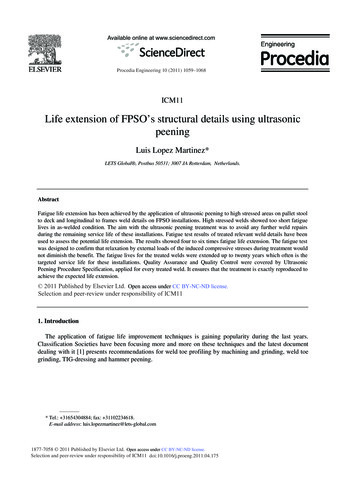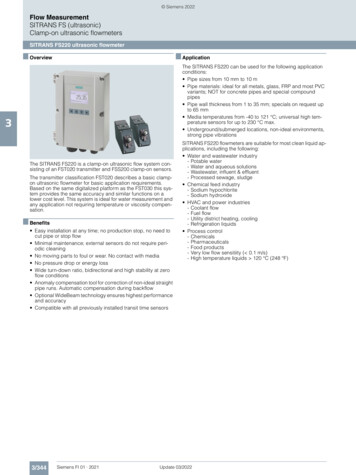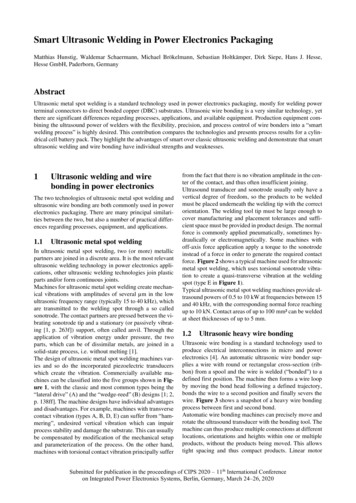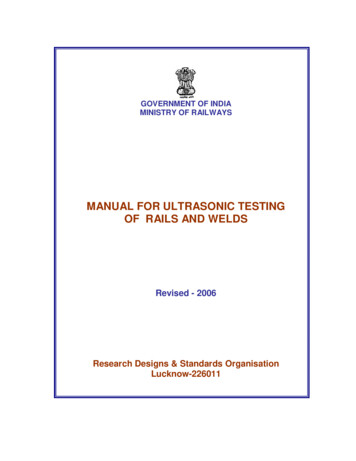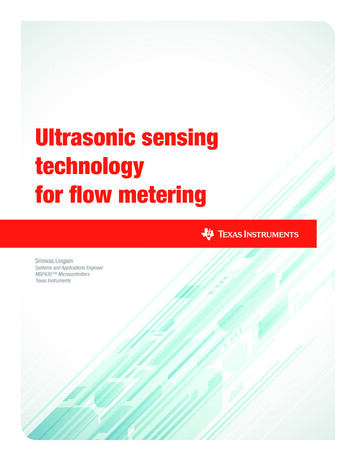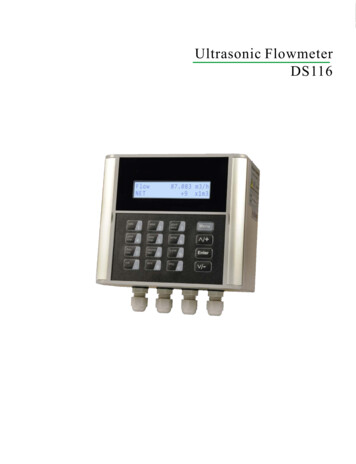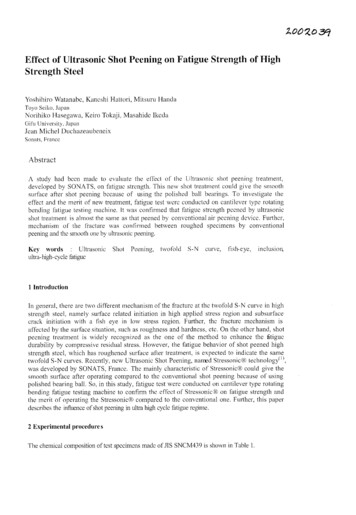
Transcription
Effect of Ultrasonic Shot Peening on Fatigue Strength of HighStrength SteelYoshihiro Watanabe, Kaneshi Hattori, Mitsuru HandaToyo Se ko,JapanNoriliiko Hasegawa, Keiro Tokaji, Masahide IkedaGifu University, JapanJean Michel DuchazeaubeneixSonats, FranceAbstractA study had been made to evaluate the effect of the Ultrasonic shot peening treatment,developed by SONATS, on fatigue strength. This new shot treatment could give the smoothsurface after shot peening because of using the polished ball bearings. To investigate theeffect and the merit of new treatment, fatigue test were conducted on cantilever type rotatingbending fatigue testing machine. It was colifirmed that fatigue streilgtli peened by ultrasonicshot treatliient is almost the same as that peened by convelitional air peening device. Ful-ther,mechanism of the fracture was confirmed between roughed specimens by conventioilalpeening and the smooth one by ultrasonic peening.Key words : Ultrasonic Shot Peening,ultra- high- cycle fatiguetwofoldS-N culvc, fiskeye,iiiclusion,1 IntroductionIn general, there are two different nechanisinof the fracture at the twofold S-N curve in highstrength steel, nan elysurface related initiation in high applied stress region and subsurfacecrack initiation with a fish eye in low stress region. F is-ther,the fracture n eclianismisaffected by the surface situation, such as roughness and hardness, etc. On the other hand, shotpeening treatment is widely recognized as the one of the method to enhance the lfitiguedurability by compressive residual stress. However, the fatigue behavior of shot peened highstrength steel, which has roughened surface after treatment, is expected to indicate the sametwofold S-N curves. Recently, new Ultrasonic Shot Peening, n a m d StressonicOwas developed by SONATS, France. The mainly characteristic of StressonicB could give thesinooth surface after operating compared to the conventional shot peening because of usingpolished bearing ball. So, in this study, fatigue test were conducted on cantilever type rotatingbending fatigue testing machine to confirm the effect of StressonicG3 on fatigue strength andthe merit of operating the StressonicO compared to the conventional one. Further, this paperdescribes the influence of shot peening in ultra high cycle fatigue regime.2 Experimental proceduresThe chemical composition of test specimens made of JlS SNCM439 is shown in Table I.
Table 1. Chemical composition (wt%)0.40.220.780.020.0130.181.780.830.2Bal.Table 2. Mechanical propertiesElongation@%)4Tensile strengtlicrrr(MPn)2274Iied xctionof areadew390.2% proof stress (MPII)1515Roughly Maclii iesspecimens were austenitized at 850 C for 60 n m and 011 quenclicd.Tempering treatment was perfor nedat 620 C for 120 min. Table 2 shows the mechanicalproperties of spccimesis after heat treat nent.AStes hcat treatment, specimens were pol shedby grinder to improve tlie surface roughened by machining. Tlie geometry of specimen isshown in Figure I . Fatlgue tests were conducted by cant levestypc sotat ngbcndiiig fatiguetesting machine of' 3,150 r.p.n.1. in cyclic speed in laboratory atmosphere. 10" cycles weretaken as liiniting iumberfor evaluation of fatig leproperties. Tlie characteristic of the vesyhigh cycle fatigue propert should be twofold S-N curves: t l one for surface fatigue and the. There are two fatigue limits: the surface fatigue limit, xi5 and theother for intcrnalinternal fatigue Iiniit, CX, although tlie latter has not yet observed clearly. Tlie s u-facefatiguelife is shorter than the inter ialfatigue life. I11 this study, we evaluate the both fatigue limit toevaluate the effect of Ultrasonic treatment.Shot peening was carried out by Stressonic@ and conventional air peening device using threekinds of shot media, bearing ball, tungsten carbide and conditioned cut wire. Figure 2 showsthe schematic illustration of StressonicB process and the appearance of treatment tospecimens. A piezo-electric transducer emits tlie ultrasonic wave at 20 kHz. Tlie waves areamplified when they travel througli an acoustic booster, in a housing which contains the partsto be treated and tlie shot. Tlie shot strike tlie vibrating walls and are reflected off the surface.Then they collide with one another. Tlie balls are scattered randomly tl ro igliouttheirencasing. A homogeneous treatment is then obtained on the surface of casing. At this study,tlie amplitude of sonotrode was 90 micrometer. Table 3 (a) and (b) shows the shot peeningconditions. Here, shot peening time were decided to obtain 100% coverage at ultrasonic shotpeening and 300% coverage for air shot peening. The hardness, density and diameter of eachshot media are also shown in Table 3.7
Table 3 (a). Shot peening conditions on StressonicBType of shot mediaThe ball bearingTungstenDensity (g/intn3)Diameter (nm)Hardness (HV)Distance between spec. and SonotrodeAmplitude of SonotrodeFrequencyRotating speed of specimenQuantity of media (gjsonotrode)Peening time( 100% coverage)Arc height (inmA)Table 3 (b). Shot peening conditions on air type peening deviceType of shot mediaDensity (gjn in")Diameter ( mn)I-Iardness (HV)Air pressure (MPa)Distance between nozzle and spec.Rotating speed of specimenQuantity of shot mediaPeening time (300% coverage)Arc height ( m A )Rounded cut wire shot (RCW)7.860.88mrnHV7000.251 60nm12r.p.m.4,750gl30sec30sec0.4831nmAFigure 2. Appeardnce and illustration of StressonicO treatmentcarbide
Table 4. Susface roughness ( pn 3RY3.465.307.55Rz2.414.235.74Figure 3. Hardness distsibutionDistance from surface d ( ,U rn)3 Results3.1 Surface roughness and hardness distributionTable 4 shows surfacc roughness after shot peening treatment. Surface rouglmess ofspeciinens peened by StsessonicO was smaller than that by conventional air peening. Thereason of this results was considered that the shot velocity on StressonicB is lower comparedto air type and the surface conditions of SUJ2 and WC, which used for ultrasonic, are muchbetter than RCW for air type. SUJ2 and WC ball were polished to get smooth surface becauseof the purpose of usage. On the other hand, rouglmess of WC was bigger than that of SUJ2because of different density and hardness.Figure 3 shows hardness distribution for the specimens after each shot peening treatment. Incase of using WC ball at StressonicO, the increase of IOOHV was observed compared tonon-peened specimen. At the conlparison between the both treatment, increase bycoi ventionalwas smaller than ultrasonic. It is explained that the difference of the results isdue to the higher hardness of WC and SUJ2 than that of Rounded cut wire.3.2 Residual stress distributionFigure 4 shows residual stress distribution for specimens peened by both shot. The residualstresses were determined by Xray diffractometer withmethod. The residual stressdistribution was obtained by repeating the X-ray measurement and electsochernicalpolishing
Figure 4. Residual stress distribution-1400;II,l1II20406080100Distance from surface d ( p m)Figure 5. Influelice of shot peening treatment on fatigue properties of SNCM439Number of cycles to failureNfsuccessively. No difference was observed between WC on StressonicB and RCW onconventional type in the depth direction. However, surface value of conventional type waslower than that of WC. Further, at StressonicB process, compressive residual stress of WCwas much higher than SUJ2. As the same results of hardness, this is derived from the
difference in hardness and density.3.2 Fatigue testFigure 5 shows the S-N curve for the each shot peened specimens. The results of n o p e e n e dspecimens are also shown. In this figure, ( x ) means that specimens failed from the internalcrack. The fatigue properties of every shot peened specimens were higher than that ofnon-peened specimens at the surface fatigue limit, cx,,. However, there were no difference atthe internal fatigue, at,.The reason of this result was considered that the depth of internalcrack initiation site is deeper than compressive residual stress layer.(1) On the other hand, the surface fatigue limit of WC shot by Stressonic@ was raised up to1250MPa and highest in all of another treatment. The reason of this result is consideredthat the surface roughness of WC was better than that of specimen peened by RCW andresidual stress profile at both treatments was almost the same, as mentioned before. As theresults, new technology, StressonicB, is useful and is expected to be alternate treatment asthe method to enhance the fatigue durability without surface roughened. In addition, thistechnology should contribute to improvement of environment because of quite smallquantity of ball usage as shown in Table 3.4 ConclusionsIn the present study, to confirm the effect of ultrasonic shot peening treatment, StressonicO,on fatigue properties, fatigue test were conducted by cantilever rotating bending fatiguemachme by using several shot peening conditions.Following is a suimnary of the results obtained;(2) Surface roughness of specimens peened by StressonicO was smaller than that peened byconventional air type treatment. And almost the same residual stress profile was observedbetween Tungsten carbide ball (WC) on StressonicB and Rounded cut wire shot (RCW)on conventional peening(3) The surface fatigue limit of WC shot by StressonicB was raised up to 1250MPa andhighest in all of another treatment. New technology, StressonicO, is useful and is expectedto be alternate treatment as the method to enhance the fatigue durability without surfaceroughened. In addition, this technology should contribute to improveinent of environmentbecause of quite small quantity of ball usage.5 References[ I ] Jean-Michel Duchazeaubeneix, SONATS, France, Proceedings of ICSP 7'", 1999,444-452.[2] Keisuke TANAKA, Yoshiaki AKWIWA, Proc. of the International Conference on Fatiguein the Very High Cycle Regime, 6 1-7 1.
So, in this study, fatigue test were conducted on cantilever type rotating bending fatigue testing machine to confirm the effect of StressonicG3 on fatigue strength and the merit of operating the StressonicO compared to the conventional one. Further, this paper describes the influence of shot peening in ultra high cycle fatigue regime.

